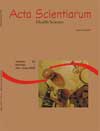<b>Movement/deambulation on birthwork: a review</b> - DOI: 10.4025/actascihealthsci.v26i2.1580
Abstract
The birth is not completely natural. This is because there are some attitudes and behavior controlled and culturally defined by society. It is physiologically better for the mother and for the baby if the mother keeps on movement during parturition. Based on these considerations, the aim of this work is to make a review about this subject in order to verify what theoretical articles consider about the effects of deambulation/liberty position and movement during the birthwork. The literature review showed that the vertical position has been the most used and preferred since the antiquity. It is because it causes less pain during birthwork and birth, decreases the birthwork and birth time limit. It improves the uterine contractility and offers more comfort to parturients. Also, it keeps the maternal-fetus-placental exchange for longer, decreasing the risk of fetal suffering.Downloads
Download data is not yet available.
Published
2008-03-31
How to Cite
Mamede, F. V., Almeida, A. M. de, & Clapis, M. J. (2008). <b>Movement/deambulation on birthwork: a review</b> - DOI: 10.4025/actascihealthsci.v26i2.1580. Acta Scientiarum. Health Sciences, 26(2), 295-302. https://doi.org/10.4025/actascihealthsci.v26i2.1580
Issue
Section
Nursing
DECLARATION OF ORIGINALITY AND COPYRIGHTS
I Declare that current article is original and has not been submitted for publication, in part or in whole, to any other national or international journal.
The copyrights belong exclusively to the authors. Published content is licensed under Creative Commons Attribution 4.0 (CC BY 4.0) guidelines, which allows sharing (copy and distribution of the material in any medium or format) and adaptation (remix, transform, and build upon the material) for any purpose, even commercially, under the terms of attribution.
Read this link for further information on how to use CC BY 4.0 properly.























5.png)







